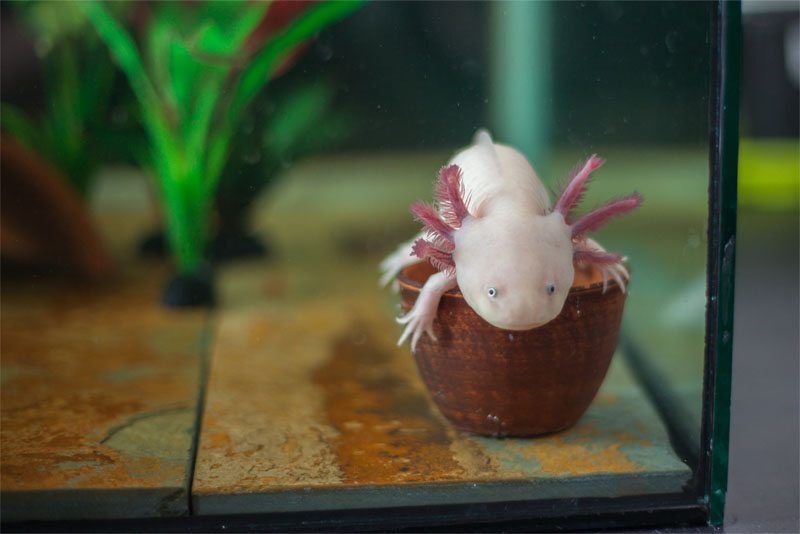Salamander Lifespan: How Long Do Salamanders Live?

One of the most common questions I see regarding salamanders is “how long do they live?” It’s a great question to ask, especially if you’re considering keeping one as a pet.
Whatever the reason is, I’ll do my best to answer this question in a way that is helpful to you.
It may surprise you to learn that some salamanders can live over 50 years. Olms, a rare type of salamander, can live around 100 years. Also, “experts” in China supposedly found a 200-year-old Chinese Giant Salamander. While that’s probably not true, all of these cases are above average.
The maximum longevity is difficult to determine but salamanders kept in captivity, under optimal conditions, tend to live longer than their wild counterparts. Keep reading to learn more.
The Lifespan of 14 Different Salamanders
I’ve created a list of species within the order Caudata (Salamanders). The list includes the maximum longevity recorded for each species.
The numbers listed in our table are from documented sources. It doesn’t mean that these salamanders are not capable of living beyond the years recorded.
| Common Name | Binomial Name | Max Longevity |
|---|---|---|
| Northwestern Salamander | Ambystoma gracile | 10.2 years |
| Three-toed Amphiuma | Amphiuma tridactylum | 15.9 years |
| Japanese Giant Salamander | Andrias japonicus | 52 years |
| Korean Salamander | Hynobius leechii | 7.1 years |
| Doflein’s salamander | Bolitoglossa dofleini | 6.9 years |
| Common Mudpuppy | Necturus maculosus | 34 years |
| Fire Salamander | Salamandra salamandra | 24 years |
| Seal salamander | Desmognathus monticola | 17.7 years |
| Tiger Salamander | Ambystoma tigrinum | 25 years |
| Marbled Salamander | Ambystoma opacum | 11.3 years |
| Spotted Salamander | Ambystoma maculatum | 32 years |
| Hellbender | Cryptobranchus alleganiensis | 29 years |
| Axolotl | Ambystoma mexicanum | 15 years |
| Olm | Proteus anguinus | 100 years |
This list contains data retrieved from the book Longevity of Reptiles and Amphibians in North American Collections by J. Kevin Bowler [1] (click here to see it on Amazon), AnAge, an “Animal Ageing and Longevity Database” [2], and other credible sources.
While I’m pointing out the source material, it’s important to know the truth behind these numbers (ages). The sources are considered trustworthy, in my opinion, but that doesn’t mean they’re completely accurate.
Many of the salamanders that live 15 years or more were kept by hobbyists, researchers, or zoos. They’re often kept in optimal conditions, away from predators and fatal weather conditions.

While looking through the database, I noticed many species within the same Genus have vastly different age lengths. The ones with a greater lifespan were probably kept in optimal conditions in captivity. For example, a zoo exhibit: One carefully monitored by trained herpetologists. Moreover, the ones with higher recorded lifespans are also some of the most popular species kept as pets (tiger salamander, spotted salamander, fire salamander, etc).
Related: The 10 Most Popular Pet Amphibians, A Salamander’s Diet: The Ultimate Guide
The species with shorter lifespans, within the same Genus, were most likely wild. Their recorded lifespan, while still trustworthy, may not reflect the possible maximum age length. Simply put, there aren’t any documented instances in which that particular species was kept under optimal conditions.
Anyway, some of this is speculation and my personal opinion.
The Oldest Salamander Ever Recorded
Now that you have a general idea of how long an average salamander lives, let’s take a look at the extremes. We’re going to examine three cases. One holds a world record, one is based on speculation and unnamed “experts”, and the last is, well, it’s a special case involving a rare salamander.
Oldest Salamander in Captivity
The Artis Zoo in Amsterdam holds the Guinness World Record by way of a 52-year-old Japanese Giant Salamander (Andrias japonicus). In fact, since 1829, the Artis Zoo has kept two Japanese Giant Salamanders that lived to the age of 52!
Their first one lived from 1829 to 1881 and the second from 1903 to 1955. To verify my findings, you can see them for yourself on the Guinness World Records website.
Now, just because it’s in the Guinness World Records doesn’t mean it’s the oldest salamander in the history of ever. It just so happens to be the oldest one documented by a trusted source. As you’ll see in the next section, some sources are more credible than others.
Oldest Salamander in the Wild
This section is split in two. The first part contains questionable sources claiming to have found a two-century-old salamander while the other one explains how a rare salamander is capable of living 100+ years. Let’s start with the former.
A 200 Year Old Chinese Giant Salamander?
In researching for this post, I came across a handful of presumably credible sources claiming to have found a Chinese Giant Salamander (Andrias davidianus) nearing 200 years of age. I’d love for this to be true but it most likely isn’t.
Naturally, however, it piqued my curiosity and as such, I dug deeper. What I found, in the end, was a singular source claiming “Experts say it may be more than 200 years old.” There is no mention of who the expert is or why he/she made this estimation (at least not that I could find).
Anyway, supposedly this 200-year-old Chinese Giant Salamander was found in a cave in southwest China, in Chongqing.
I believe that trying to prove whether or not this claim is credible is a fruitless endeavor. Instead, I’ll drop this and point you in a different direction.
Olms have a predicted maximum lifespan of 100 years or more…

This claim is credible and backed by years of research. Olms (Proteus anguinus), also known as “Human Fish”, are blind, cave-dwelling salamanders found in Slovenia. It’s believed that adult Olms live an average of 68.5 years but their maximum lifespan is over 100 years.
Olms have no predators in their natural environment. Also, they’re relatively large compared to the other creatures found in the caves. Researchers believe being large and in a predator-free environment, along with other physiological characteristics, are what contribute to an extreme lifespan [3].
Biologists have set up cave laboratories for studying Olms and other cave-dwelling creatures. One story follows Gregor Aljančič, a cave biologist, who’s been visiting the same cave since childhood. He went there with his father who established the cave lab in 1960.
Wild vs Captive Lifespan
The quality of life has a huge impact on the lifespan of salamanders. If you compare two salamanders, one in the wild and one in captivity, the one in captivity usually lives longer. This is mostly because captive inhabitants aren’t exposed to predators, extreme weather, etc. It’s not that cut-and-dry, however.
This assumes the salamander in captivity is kept under optimal conditions and the one in the wild is exposed to a harsh environment. In this case, captivity usually results in more years. After all, a salamander in the wild is exposed to predators, fluctuating weather, and nowadays, loss of habitat and chemical pollution.
It’s easy to see why salamanders tend to live longer in captivity. That’s not to say that you can go and buy one from your local pet store and expect it to live 50+ years. Unfortunately, the opposite is likely to happen unless you’ve done your research.
Amphibians are especially vulnerable to water quality. One can’t simply squirt a dechlorination agent into an aquarium filled with tap water and expect the salamander to be happy and healthy.
In the case of Olms, as mentioned above, they are perfectly adapted to their natural environment which is largely unchanged by human pollution (until recently). Meanwhile, they have no predators in their caves. It’s hard to say, in this case, that an Olm in captivity would outlive one in the wild.
TLDR; How Long Do Salamanders Live?
Salamanders have varying lifespans depending on the species, genetics, and other factors. Regardless, most salamanders live between 5 – 15 years in the wild. They usually live longer in captivity, assuming the conditions are optimal.
The Guinness World Record is held by a 52-year-old Japanese Giant Salamander. Although it’s unlikely, a questionable source reported a 200-year-old Chinese Giant Salamander back in 2015. Finally, there are extremely rare, cave-dwelling salamanders called Olms that have a predicted maximum lifespan of 100 years or more.
Featured photo by: Evgeny / Adobe Stock
References
- Bowler, K. J. (1977). Longevity of Reptiles and Amphibians in North American Collections (1st Edition. ed.). Society for the Study of Amphibians and Reptiles.[↩]
- AnAge: The Animal Ageing and Longevity Database. (n.d.). AnAge. https://genomics.senescence.info/species/index.html[↩]
- Voituron, Y., de Fraipont, M., Issartel, J., Guillaume, O., & Clobert, J. (2010). Extreme lifespan of the human fish ( Proteus anguinus ): a challenge for ageing mechanisms. Biology Letters, 7(1), 105–107. https://doi.org/10.1098/rsbl.2010.0539[↩]
